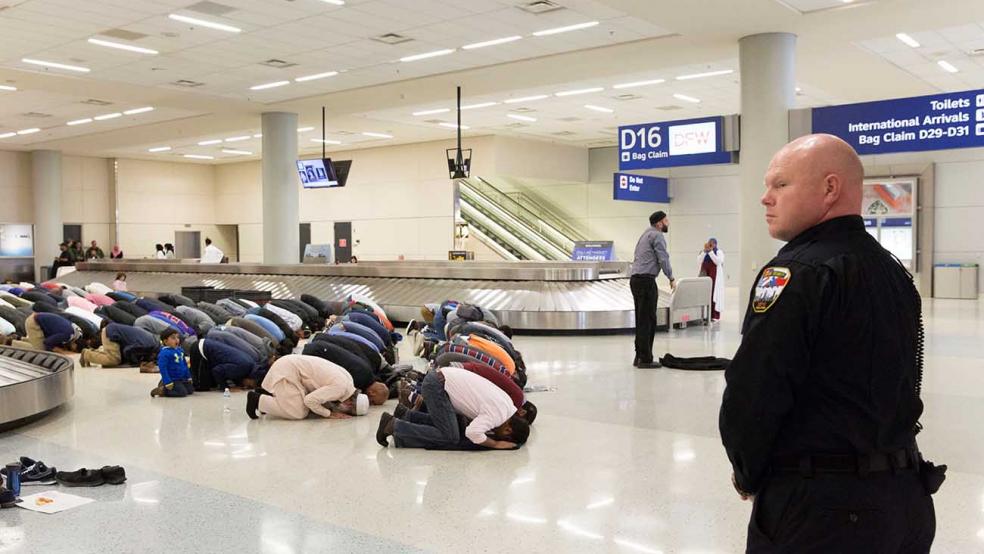With the restriction on immigration for travelers from seven majority-Muslim countries stayed by a federal court, appeals courts reviewing Donald Trump’s executive order and the State Department reversing its visa cancellations for those affected, you might assume that a rough equilibrium has been established: Americans resisted a ban they considered an affront to their values, and an independent judiciary working its will reversed the whims of a president.
But even if the courts ultimately disallow the executive order to take effect, the picture of America as a welcoming country for immigrants has changed, perhaps irrevocably. In short, the Muslim ban is working to achieve Trump’s goals, order or no order.
Related: 12 Facts We Now Know About President Trump
When immigrants flee violence or seek better economic opportunity, they must choose where to find refuge. America has historically been a key destination, with not only positive consequences for individuals, but for our economy. Fresh influxes of working-age adults usually expand wages and employment, contrary to claims that immigrants take Americans’ jobs. More workers and consumers create new opportunities for business expansion and output, as we’ve seen in America for centuries.
Creating a hospitable environment for immigrant families is central to making this all work. That’s what the Trump order overturned, even if it accomplishes nothing else. Rolling up the welcome mat could be enough for foreigners to effectively ban themselves from America.
This Los Angeles Times profile of a naturalization ceremony focuses on Muslim immigrants beginning to wonder whether they want to become U.S. citizens after all. “It doesn’t feel as welcoming right now,” one said. For those who go through the already arduous process to become naturalized citizens, turning back because of one executive order is impractical. But for the student who wants to matriculate at a U.S. research university, or the tourist who wants to see the Grand Canyon, or the young Mexican seeking a better life for their family or the refugee who needs to find sanctuary to relieve their hazardous plight, the decision to avoid America is easier. That was the entire point.
Related: Why British Parliament Is Threatening to Slam the Door on Trump
Steve Bannon, the white nationalist who masterminded the executive order, appears to simply want fewer non-white people to come into this country. Whether he hits that goal by prohibiting entry or simply by making America more undesirable for people of color is immaterial. Setting the tone can do the work that the Constitution might disallow.
This won’t necessarily change minds overnight. America still has plenty to offer the foreign traveler. But throughout the next four years, I would gather that visits to the United States from predominantly Muslim countries, and perhaps all countries, will drop, regardless of the fate of the executive order. Eventually, people get the message that they’re not wanted.
So what does that mean for the country? Let’s start with research, where one out of every six scientists working in the U.S. is an immigrant. Will they continue to flow in, or choose other developed countries in Europe or Asia to ply their trade? And what does that mean for basic research in America? None of the answers to those questions are good for innovative enterprises or the future of scientific breakthroughs, which rely on close collaboration and networking.
Related: Will Trump Restore 4% Growth or Crash the Economy?
The impact on research science closely mirrors the fallout for higher education. Practically every academic site in America has spoken out against the travel ban, because they know it will reduce the level of talent on their campuses. Students with scholarships to American universities are now considering Canadian alternatives, and applications to top schools to the north like McGill and Brock University have surged.
In an interview during the presidential campaign, Bannon steered Trump away from believing that foreign students who benefit from our educational resources should be allowed to stay here to work or start businesses. The best way to prevent that is to stop the pipeline at the source. And that simply denies the country productive capacity from individuals who want to work here.
There’s some early evidence that the travel ban has already had an impact on the tourism industry, which supports over 1 million domestic jobs. Various international booking agents are showing fewer searches for U.S. flights. The red tape that international airlines experienced with the rocky rollout of the ban could make them less likely to add or maintain their flight schedule.
Related: Is Trump’s Travel Ban Already Hurting US Tourism?
In other words, the travel ban — and more importantly, the belligerent posture toward immigrants from official sources at the height of the government — is a self-inflicted wound. Those in power just wanted to make it hard, humiliating and treacherous to enter the United States as a foreign national. They’ve done it — to the harm of not just our image abroad, but to tangible segments of our economy and society.
The flip side of this is that, as much as the tone of unfriendliness locks people out, it also locks people in. Dual citizens who travel back and forth to their home countries probably won’t go as much. Severing those ties keeps them stateside, where millions of immigrants from abroad, both legal and undocumented, already live and work and play. In America, a retreat into white supremacy is impossible at this juncture. As of 2010, four states, including my home in California, are majority-minority. The country is headed in that direction by 2044, according to a recent Brookings Institution report. There are more Latinos in the Golden State than Caucasians.
Even if walls were erected and foreigners kept away, America is browning in ways that are inescapable. Ultimately, that will crumble the effort to use anger as a weapon to stall an inevitable future. To the immigrant, America shows an unwelcoming face in the Trump era. But that face is bound to change, both in color and in temperament.






